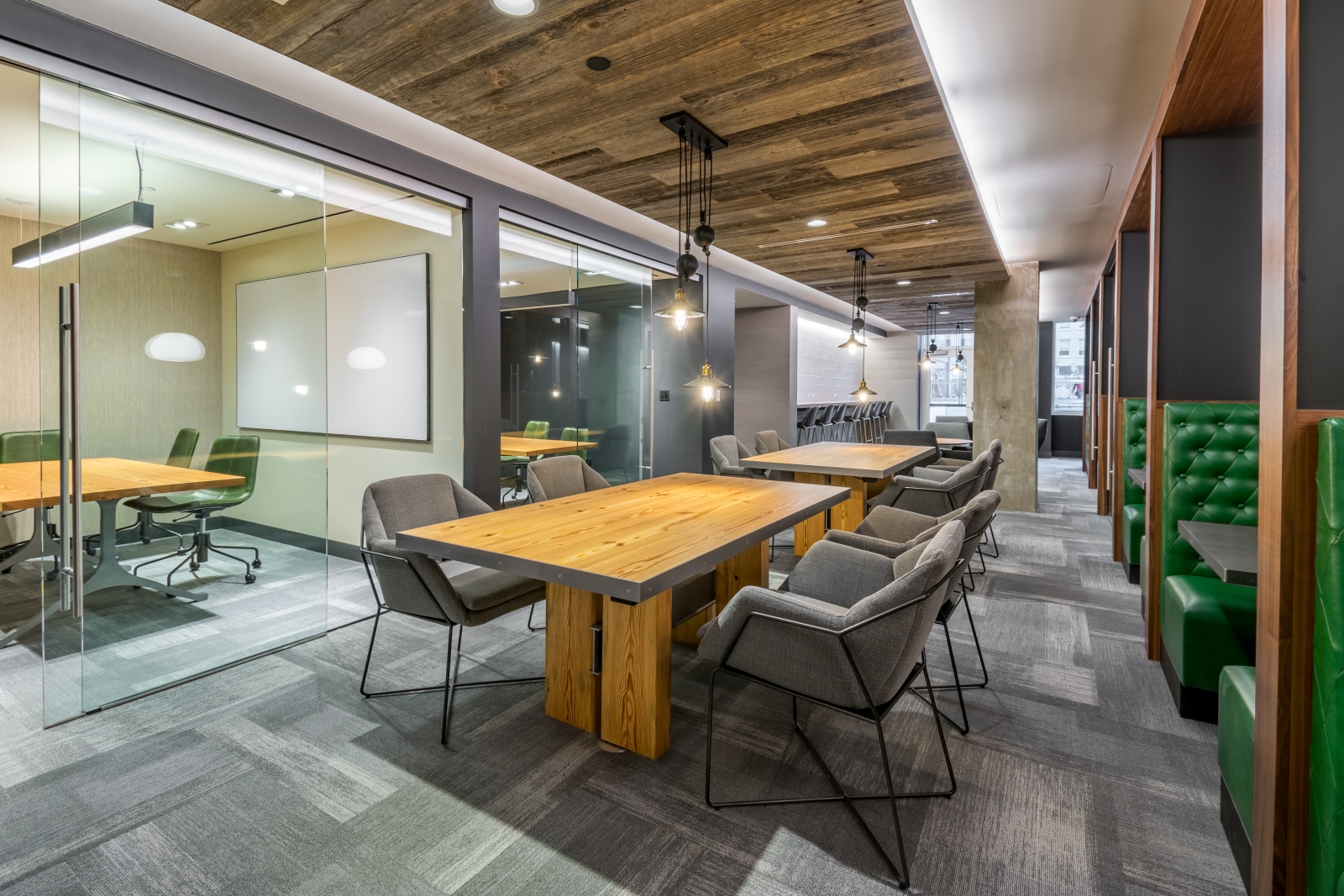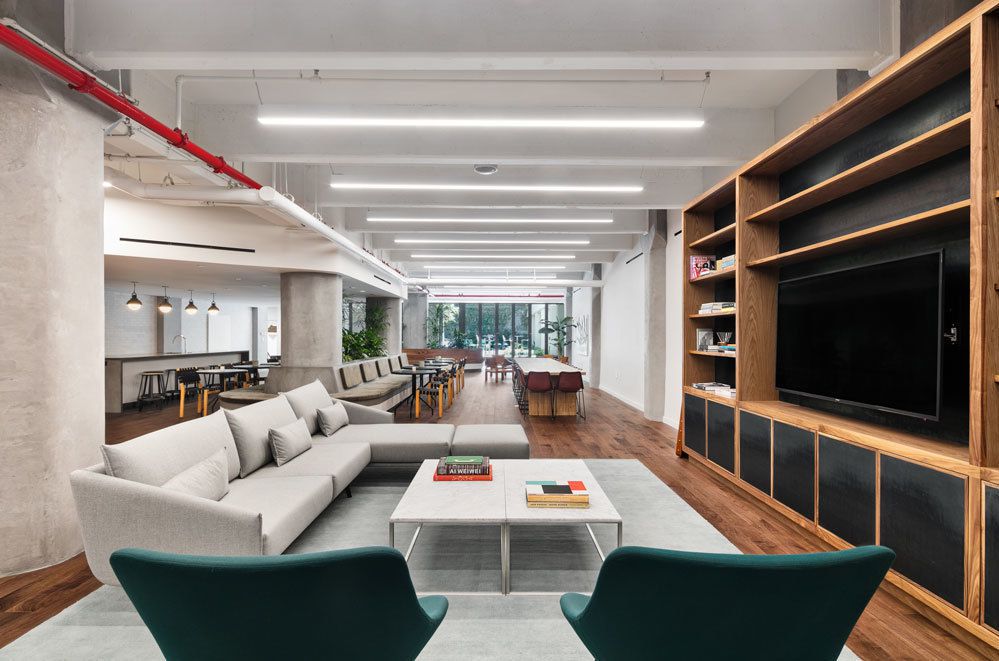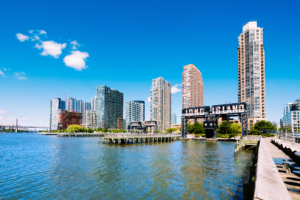
HomeWork, a coworking space built into a new development at 33 Bond St. in Brooklyn, comes with coffee. (Source: TF Cornerstone)
For those who only know office life, the idea of working from home can hold immense appeal. Taking conference calls in pajamas and meetings in bed seems idyllic — especially on apocalyptic winter days or steamy summer ones, when commuting seems like a job in itself.
These days, working from home is a reality for a huge number of people. According to a 2017 Gallup poll, more Americans are working remotely now than in the past, and the trend is only growing. With the rise of the “gig economy,” companies are relying more on contract, part-time and short-term workers, which often means employees are not collaborating in a traditional office.
But just because someone works remotely does not necessarily mean they work from home. The last few years have seen organized coworking spaces such as WeWork and Croissant pop up around the world. With 48 offices in NYC alone (out of a whopping 253 locations in 22 countries), WeWork has become an attractive option for employers and individuals. Its spaces are the antithesis of dreary, old office buildings, with cool decor, comfortable seating, and an emphasis on lifestyle and community. The company is now valued at north of $20 billion, and is growing rapidly, fueling speculation that it may soon go public.
But WeWork is not alone in the workspace game. Competition is coming locally from a surprising corner: the luxury apartment market. Developers of fancy new buildings are starting to add communal workplaces to their lists of amenities — one more feature along with those gleaming gyms and sprawling roof decks. These are not generic conference rooms or hotel-style business centers, but design-oriented spaces intended to be somewhere you’d enjoy sitting down at your laptop and sipping coffee.
TF Cornerstone, which specializes in luxury residential buildings, is one developer addressing the workspace need. “We started noticing that more and more of our residents have flexible schedules, and were working from our lounges during the day,” explains Donika Beselica, TF Cornerstone’s communications and events manager. The team reacted by revamping the lounges at properties like FiDi’s 2 Gold St. and 45 Wall St. with more charging outlets and work-friendly tables and furniture. Residents seemed to use these resources more and more, so the company went one step further with 33 Bond St., a 714-unit rental building located in Downtown Brooklyn, which now boasts its own coworking lounge, called HomeWork. “Opening resident-only coworking space as a new amenity in our buildings was a natural extension” to enhanced lounges, Beselica says.
With communal tables, private conference rooms, workstations, high-speed WiFi, a self-serve coffee kitchenette and an outdoor space, HomeWork is the space of a remote worker’s dream. It’s a comfortable office — with outlets galore — to get stuff done, and functional enough that residents never need to leave the building. It’s great for anyone looking for a “quiet space to work during the day, get out of their apartment for a bit, socialize and network with other residents,” Beselica says. While WeWork is changing the nature of office space, TF Cornerstone seems to be addressing a larger lifestyle change, giving remote workers social opportunities, comfort and convenience.
And the trend is catching on. With the success of HomeWork at 33 Bond, TF Cornerstone has added coworking spaces in its latest Hell’s Kitchen project, 606W57. Other city properties are also jumping on the bandwagon: Brooklyn’s waterfront Austin Nichols House has coworking spaces, as does the gleaming 15 Hudson Yards skyscraper.

The Austin Nichols House, in Williamsburg, also offers a coworking lounge for residents.
But the question remains: do people actually like remote-working lifestyles? Unsurprisingly, the answers vary. Katie Burwell, a sales engineer at a software company, loves certain aspects of it, like the flexibility and the productivity. “My entire office is in the bag I carry, so I can connect to my hot spot and get work done anywhere,” she says. “It’s also very nice to have the option to work from home when I don’t have any meetings in the city, or there is a blizzard, or I want to make homemade soup for lunch.”
But the flip side to such freedom, Burwell adds, is total connectivity. “I can slip into workaholic mode. If I’m out, I’m always connected. Whether at dinner, happy hour, or shopping, working remotely can imply 24/7 access, which isn’t always a positive.” But, she says, “overall I have higher satisfaction in my work and life working remote.”
Alina Cohen, a freelance culture writer, describes her transition from working at home and at neighborhood coffee shops to investing in a coworking space: “I was being unproductive at home, spending way too much money at coffee shops, and seeking a physical divide between the places I worked and relaxed.” Cohen started going to Work Heights in Crown Heights, and explains, “It did the trick. There’s free coffee here and a fridge, soundproof booths for when I need to conduct phone interviews, plenty of quiet workspace, and some happy hours.” Despite not having a traditional office, she’s created one that has many of the social perks of a standard workspace — but also offers autonomy and relief from the rush-hour commute.
If the downside of working remotely has long been a sense of isolation, coworking spaces, whether attached to an apartment building or not, ease that. “You see the same people all the time, and you can make friends—or at least acquaintances,” instead of sitting in your apartment all day, Cohen says.
But there are some major differences between a coworking space and a true office. “If you date and then break up with someone at your coworking space, no HR person is going to care,” Cohen says. “But things can still get weird.”
—
Hey, why not like StreetEasy on Facebook and follow @streeteasy on Instagram?









